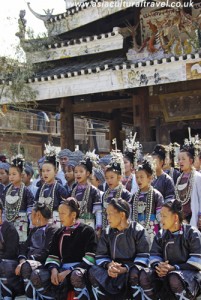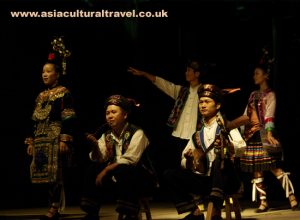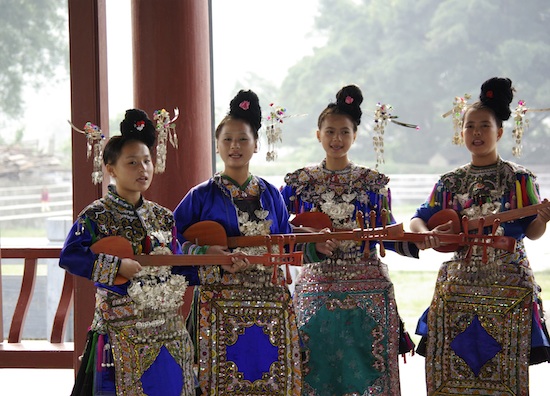From dusk till dawn, the villages of the Dong people are saturated with the harmonious sound of singing. This ethnic group has become famous throughout China for polyphonic folk songs known as “Dage” or Grand Songs. While some of these folk songs are accompanied by the pipa[1], most are sung without any musical accompaniment. The Dong ethnic minority have no written language, so they use folk songs to narrate their daily life, express their feelings, and keep a record of their history. All of Dong culture is preserved in these magnificent folk songs. The more songs a Dong person knows, the better educated they are considered to be. Singing is so important to the Dong people that supposedly, in the past, if a man couldn’t sing then he would struggle to find a wife!
From the age of five, children in the village will be trained by one of the accomplished local singers free of charge. These singing teachers enjoy a special status as highly revered members of the community. In short, people are always singing their praises! Depending on age and gender, villagers are separated into different choirs, and each choir is distinguished by their particular style of singing and the topics of their songs. For example, choirs of young children will sound sweet and lively, while choirs of young girls sound innocent and full of passion, and choirs of men have a depth to their voices that sounds haunting and powerful. Female choirs incorporate sopranos, mezzo-sopranos, and contraltos, and male choirs are comprised of countertenors, tenors, baritones, and basses.
 The most talented singers in any Dong village make up what are called Kam Grand Choirs or Kgal Laox in the native Dong language. The Kam Grand Choir tradition is thought to have originated sometime during the Warring States Period (475BC-221 BC), making it over 2,500 years old! In 2009, it was made a World Class Intangible Cultural Heritage by UNESCO. A Kam Grand Choir is a polyphonic choir that sings without the help of a conductor or any accompanying orchestra. Most songs performed by these choirs consist of a prelude, a main body made up of several sections, and an ending.
The most talented singers in any Dong village make up what are called Kam Grand Choirs or Kgal Laox in the native Dong language. The Kam Grand Choir tradition is thought to have originated sometime during the Warring States Period (475BC-221 BC), making it over 2,500 years old! In 2009, it was made a World Class Intangible Cultural Heritage by UNESCO. A Kam Grand Choir is a polyphonic choir that sings without the help of a conductor or any accompanying orchestra. Most songs performed by these choirs consist of a prelude, a main body made up of several sections, and an ending.
These songs are designed to imitate the natural world, such as the chirping of insects, the gurgling of streams, the whistling of the wind, and other soothing natural sounds. The singing is meant to spur the soul and originate from the heart, while simultaneously promoting harmony between mankind and nature. The solo singing will be done by the sopranos and the bass section is sung by the rest of the choir. Depending on the style of song, the soprano section will be performed by between one and three individuals.
There are Male Choirs, Female Choirs, and Child Choirs, and each of these is further separated into four main categories based on their styles, melodies, and the content of their songs. In the Dong dialect, these four categories are called Gating, Gama, Gaxiang, and Gaji. Gating or “Choirs of Sound” perform songs that are characterised by an undulating melody and short lyrics, employing the use of several sopranos. This style of song is dedicated almost entirely to imitating the sounds of the natural world, with the famed “Cicada Song” being the finest example. Gama or “Romance Choirs” perform songs revolving around the theme of love and employ slow rhythms and soft voices to heighten their effect.
Gaxiang or “Morality Choirs” perform songs that are designed to educate, advise, or console the audience by praising virtues and condemning inappropriate behaviour. These songs have an even tune in order to draw focus to their lyrics. Finally, Gaji or “Narrative Choirs” perform songs that focus on dialogue and plot, and are characterised by slow, melancholy, or soothing tunes. The Gaji songs are some of the hardest to perform, as they require the performers to remember lengthy lyrics, complicated plots, and various key facial expressions. Usually these songs will be led by only one soprano.
 Many folktales are preserved in Dong oral literature, usually in the form of songs. The focus of many popular tales re-count the leaders of past uprisings, such as Wu Mian, who led the 1378 rebellion against the Ming Dynasty during drought and famine, and Wu Jinyin, who revolted in 1740 because of a rise in grain taxes. Non-historical folktales include the two orphan brothers, Ding Lang and the dragon princess, the frog and the swallow, the dog, and the singing tree.
Many folktales are preserved in Dong oral literature, usually in the form of songs. The focus of many popular tales re-count the leaders of past uprisings, such as Wu Mian, who led the 1378 rebellion against the Ming Dynasty during drought and famine, and Wu Jinyin, who revolted in 1740 because of a rise in grain taxes. Non-historical folktales include the two orphan brothers, Ding Lang and the dragon princess, the frog and the swallow, the dog, and the singing tree.
The best time to enjoy the singing of the Dong people is during their New Year festival, which is normally sometime between late October and early November every year according to the Chinese lunar calendar. The New Year celebrations are resplendent with lively singing competitions, joyous folk dances, and vibrant performances that are truly magnificent to behold.
[1] Pipa: A four-stringed plucking instrument that has a pear-shaped wooden body and anywhere from 12 to 26 frets. It is sometimes referred to as the Chinese lute.
Join a travel with us to enjoy the Performance of Dong Ethnic Minority: Explore the culture of Ethnic minorities in Southeast Guizhou
